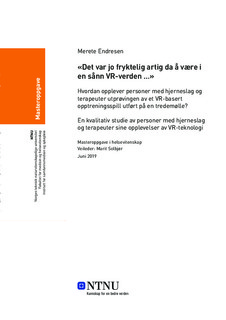| dc.description.abstract | Bakgrunn: Teknologibasert rehabilitering med bruk av VR-teknologi, blir i dag anvendt i den vestlige verden. Effekten av teknologibasert rehabilitering har vist seg å være like bra eller bedre sammenlignet med tradisjonell rehabilitering for personer med hjerneslag. Det har blitt rapportert om økt motivasjon, engasjement og glede ved bruk av teknologien. Frem til nå har få studier undersøkt hvordan personer med hjerneslag og terapeuter opplever å benytte slik teknologi.
Problemstilling: Hvordan opplever personer med hjerneslag og terapeuter utprøvingen av et VR-basert opptreningsspill utført på en tredemølle?
Teori: For å belyse funnene i studien, er det valgt å anvende teori om motivasjon og flyt. I tillegg skal funnene bli drøftet med grunnlag i teori om GameFlow for å undersøke opplevelsen av flyt hos deltakerne etter utprøvingen av VR-spillet.
Metode: Dette er en kvalitativ intervjustudie med tematisk tilnærming i analysen. Det er gjennomført ti semistrukturerte individuelle intervjuer. Fem intervjuer var med personer med hjerneslag, og fem intervjuer var med terapeuter. I forkant av intervjuene gjennomførte alle deltakerne en fysisk utprøving av et VR-spill kalt 3D-mølla.
Resultat: Funnene belyser at VR-basert rehabilitering er en motiverende og artig måte å trene på. Deltakerne beskrev en opplevelse av flyt, en følelse av å være inne i spillet og glemme tid og sted. Dette var noe de ikke hadde opplevd ved tidligere tradisjonell rehabilitering. Deltakeren satt pris på å trene både fysiske funksjoner samt kognisjon samtidig i spillet. For at
teknologien skal bli brukt i et rehabiliteringsforløp, er det viktig at det ikke oppstår programfeil, og at spillet kan ha ulike vanskelighetsgrader slik at det kan tilpasses enkeltindividers ferdighetsnivå. På den måten kan det blir aktuelt for flere å anvende 3Dmølla i eget rehabiliteringsforløp.
Konklusjon: Det er et ønske fra både personer med hjerneslag og terapeuter at
teknologibasert rehabilitering i større grad skal bli benyttet på rehabiliteringsenheter. Dette begrunnes med at det er noe helt nytt, det gir motivasjon, og man har mulighet til å få raske tilbakemeldinger. I tillegg beskrev deltakerne ulike endringsforslag for at 3D-mølla skulle bli mer anvendelig i et rehabiliteringsforløp. For å verifisere funnene er det nødvendig med mer forskning på området.
Nøkkelord: VR-teknologi, rehabilitering, opplevelser, flyt, motivasjon, hjerneslag, terapeuter | |
| dc.description.abstract | Background: Technology based rehabilitation, including the use of VR technology, is increasingly utilized in rehabilitation units in the western world. The effects of using technology-based rehabilitation is as good, or better than conventional therapy for persons with stroke, and the technology has been reported to increase motivation, attention and joy. Until now, few studies have examined how users experience this technology.
Research question: How does persons with stroke and therapists experience a trial of a VR game performed on a treadmill?
Theory: To discuss the findings in the study, theory about motivation and flow is used. The findings are also discussed based on theory about GameFlow. This is to examine the experience of flow in the VR-game by the participants.
Method: This is a qualitative interview study with a thematic analysis. Ten semi structured interviews were conducted. Five interviews with persons with stroke, and five interviews with therapists. Before the interviews were done, the participants attended a try-out of a game called 3D-mølla.
Results: The findings show that VR-based rehabilitation is a motivating and fun
way to exercise. An experience of flow, where the participants got a feeling of being inside the game and forgot time and place, was a new experience for the participants. The participants appreciated to train both physical function og cognition at the same time in the game. If the technology is to be used in rehabilitation units, it should have a low rate of software glitches, and the difficulty of the game should be adaptable to the individual’s skill levels. This way, more individuals can use 3D-mølla in their own rehabilitation processes.
Conclusion: Both the persons with stroke and the therapists wish that technology-based rehabilitation shall be used in rehabilitation units. This statement is based upon the fact that the technology is new, it gives motivation, and the players has the opportunity to receive quick feedback. The participants described different suggestions for changes of 3D-mølla to become even more usable in rehabilitation units. In order to verify the findings, more research is necessary.
Keywords: VR technology, rehabilitation, experiences, flow, motivation stroke, therapists, | |
